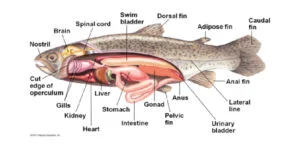
Anglers of all skill levels from pros to hobbyists like William Waner, especially those who are fishing in deep waters, need to understand the swim bladder. This is an important organ for fish, but it can also put their lives in danger when they are reeled to the surface.
By understanding how to identify and deal with swim bladders issues, you can be a more responsible angler.
THE SWIM BLADDER
The swim bladder is essentially a sac that fills with air. It is used to regulate depth and buoyancy, allowing fish to stay at certain levels without having to use energy on swimming. It has been theorized that the swim bladder is very similar to the lungs, as it shares many of the same characteristics.
Swim bladders can also be used as a resonating chamber, helping fish send and receive noises. While swim bladders are present in many bony fish, they are not found in sharks or rays.
PROBLEM WHEN BEING CAUGHT
When a deep-water fish with a swim bladder is caught and pulled up towards the surface, the pressure on the fish rapidly decreases, allowing the swim bladder to expand. Before it was caught, heavy pressure from the deep water kept the swim bladder small, but while rising to the top at a fast rate, the fish can’t release the air in the bladder. If released without venting the swim bladder, the fish won’t be able to return to the deeper water. It could easily die at the top before being able to swim back to deeper waters.
PROPERLY VENTILATING A FISH
 In most cases, properly ventilating the fish by releasing the air in the swim bladder will allow them to return to the deep water. Many tackle stores will have ventilating tools that you can use to release the air. These typically resemble a medical needle, with a long, thin, sharp point for puncturing the swim bladder and a passage through the tool that allows air to escape.
In most cases, properly ventilating the fish by releasing the air in the swim bladder will allow them to return to the deep water. Many tackle stores will have ventilating tools that you can use to release the air. These typically resemble a medical needle, with a long, thin, sharp point for puncturing the swim bladder and a passage through the tool that allows air to escape.
To properly deflate a fish, hold it on one side and pierce the fish around the midsection, holding the needle at a 45-degree angle with the handle tilted back towards the tail. The needle should be inserted about one or two inches behind the base of the pectoral fin.
Gently push the needle deeper until you hear the sound of air escaping. Like a basketball loosing pressure, you may be able feel the fish decompressing. Be careful to avoid poking the tool too deep or puncturing other organs. And don’t worry, the hole that you made in the swim bladder will heal, allowing the fish to return to full health.
As soon as possible, put the fish back in the water, but don’t release it just yet. Hold on to the tail and allow the fish to revive itself. Once the tail movement starts to increase, let the fish return back to its deep-water home.
By practicing responsible fishing habits, you are ensuring a strong population of fish for yourself and future generations. Understanding swim bladders and how to return healthy fish is essential if you want to be a smarter, more effective angler.

